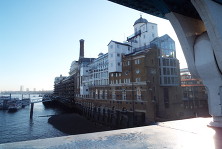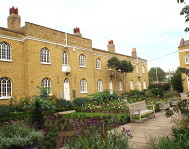








Dulwich Cottage Company Ltd
and Dekker Road
Dulwich Village is renowned for its leafy streets and large expensive houses. In January 1876 the Builder magazine commented on the mansions that were “springing up so rapidly” on the Dulwich College Estate. This brought work for gardeners, cooks, laundresses, and all those occupations that tended to the needs of the wealthy and their homes. While the number of homes for the rich was increasing, there was an increasing shortage of accommodation for the low-paid.
The cottages in both Boxall Road and Calton Avenue were designed by Charles Barry Jnr, the architect to the Dulwich Estate, in the "Dutch/German" style. Despite the requirement that the cottages were to be let at a low rent, this had to be balanced with the need that they blend in with the character of the locality.
To address this need, one of the Governors of Dulwich College, along with others, set up the Dulwich Cottage Company Ltd (DCCL) to provide low rental housing for those who attended to the wealthy and middle class of Dulwich. They acquired some land from Dulwich College Estate that faced onto the newly built stretch of road that extended Boxall Row (now Road) to Turney Road where six cottages were built in 1876.
Further cottages were built on land that had formerly been a part of the garden of Ash Cottage. The lease for the cottage and garden expired in 1877 and the College did not renew it in order to offer some of the land to the DCCL. The main block of new cottages were completed in 1878 with further accommodation added at each end of the block a year later. A short while later, Calton Road (now Avenue) was built from Court Lane to Woodwarde Road which the new cottages now faced onto. A search of the 1891 census reveals that the cottages in Calton Avenue were rented by tenants whose occupations included gardeners, a general servant, carpenters, laundresses, a coachman, charwomen, postmen and a railway ticket collector.
But as more large houses were built, the need for low cost accommodation also increased. There had been complaints from the local clergy regarding the shortage and in 1901 the Governors of the Dulwich College Estate began to resolve the situation, perhaps prompted to do so by a letter from the Town Clerk of Camberwell Borough Council.
A site was selected adjacent to the DCCL cottages which Dulwich College Estate had found hard to let because of the proximity to the cottages. This would entail the building of a new road between Court Lane and Woodwarde Road, parallel to Calton Avenue. The new road was named after the playwright Thomas Dekker and contemporary of Edward Alleyn.
Designs were prepared by Charles Barry Jnr and enquiries made regarding loans to finance the building of the new housing. The London County Council were unable to provide a loan but offers were received from the Public Works Loan Board and Prudential Assurance. The new estate, comprising 24 single cottages on one side of the new road and 18 double tenement cottages facing on the other side of the road, was completed in 1904.
The Estate advertised for tenants but there was a shortage of applications from those with occupations considered working class. It seem the rents were set too high to be affordable for those for whom the accommodation was aimed, indeed a large number of uncompleted application forms were received with just the message that the rents asked were too expensive for the applicants.
Just after the First World War, Dulwich Estate came under further pressure from Camberwell Borough Council to provide low-cost housing for the working classes under the Government’s Homes for Heroes campaign. The Estate negotiated hard with the Council and the resultant Sunray Estate was leased to the Council for 200 years with just under 300 homes built and let by the Council built along garden city lines.
(With thanks to the authors of articles found on the Dulwich Society website.)